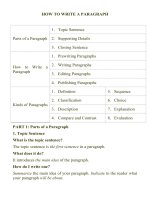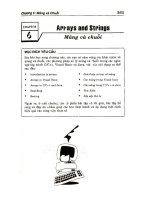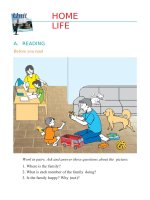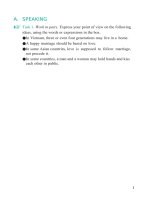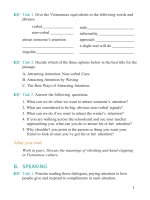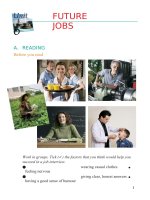Sách giáo khoa tiếng anh 12 phần 11
Bạn đang xem bản rút gọn của tài liệu. Xem và tải ngay bản đầy đủ của tài liệu tại đây (840.14 KB, 12 trang )
A. LISTENING
Before you listen
●
Work in pairs. Discuss and choose the best answer A, B or C.
1. You can find gorillas in
A. Europe
B. Asia
.
C. Africa
2. The male gorilla may attain a
height of
m and a weight of
about 180 kg.
A. 3
B. 1.7
C. 0.8
3. The life span of a gorilla in the
wild is about years.
A. 30
B. 40
● Listen and repeat.
gorilla
sociable
bared teeth
silverback
C. 50
sub-adult
civil war
nest
forest rangers
While you listen
Task 1. Listen to the passage and choose the best answer A, B, C or D
to each question.
1. Which of the following can be a group leader?
A. The biggest and strongest adult male gorilla.
B. A female gorilla.
C. The biggest adult female gorilla.
D. A grown-up gorilla.
2. With whom do baby gorillas sleep at night?
A. Their sisters.
B. Their mothers.
C. Their fathers.
D. Their mothers and sisters.
1
1
3. Why do hunters kill mountain gorillas?
A. For their skin.
B. For their nests.
C. For the trees they live in.
D. For food.
4. Which of the following statements is NOT true?
A. Mountain gorillas live in Africa.
B. Scientists study gorillas and show a different picture of
mountain gorillas.
C. Life for mountain gorillas is peaceful.
D. A gorilla sometimes eats worms.
5. What can be learned from the passage?
A. Mountain gorillas are not as dangerous as they look.
B. Mountain gorillas live in groups.
C. Mountain gorillas eat mainly plants.
D. All of A, B and C are correct.
Task 2. Listen again and complete the chart below.
General features
(1)
(2)
, gentle, sociable, and
Group members
the silverback, one or two sub-adult males,
(3)
Food
(4)
Place for
sleeping
nest (5)
Causes of being
endangered
(7)
(8)
and worms
or (6)
, hunters killing them for food,
After you listen
Work in pairs. Summarise the main ideas of the passage, using the
information and the answers in Tasks 1 and 2.
B. WRITING
Task 1. Work in pairs. Suggest possible measures that should be taken
to solve the following problems.
●
●
●
●
People do not know much about the need to protect rare and
endangered animals.
Projects to save endangered animals do not have sufficient funds.
The habitats for endangered animals are being seriously damaged
and polluted.
People who live in or near endangered animals’ habitats have poor
living conditions and rely mostly on wildlife products for their
livelihood.
●
Some countries do not have laws to protect endangered animals.
●
People keep buying fashionable wildlife products.
●
There are not enough wildlife habitat reserves.
Example:
People do not know much about the need to protect rare and
endangered animals. We should organise different activities to raise
people's awareness of the need to protect these animals.
Task 2. Write a paragraph about measures for protecting endangered
animals using the ideas discussed in Task 1. Begin your paragraph
with:
“There are a number of measures that should be taken to protect
endangered animals.”
C. LANGUAGE FOCUS
● Pronunciation:
Rhythm
● Grammar: Modal verbs: may, might, must, mustn’t, needn’t
Pronunciation
●
Practise reading the following sentences, paying attention to the
stressed syllables.
1. Tell me the time.
2. Show me the way.
3. He bought some carrots and cabbages.
4. Come for a swim.
5. Look at the clock on the mantelpiece.
6. I think he wants to go tomorrow.
7. It’s not the one I want.
8. Most of them have arrived on the bus.
9. Walk down the path to the end of the canal.
10. I’m going home today for Christmas.
11. A bird in the hand is worth two in the bush.
12. If you don’t have the best, make the best of what you have.
Grammar
Exercise 1. Complete the sentences, using may/might with one of the
verbs in the box.
bite
break
need
rain
slip
wake
1.Take an umbrella with you when you go out. It might rain later.
2. Don’t make too much noise. You
the baby up.
3. Be careful of that dog. It
you.
4. I don’t think we should throw that letter away. We
it later.
5. Be careful. The footpath is very icy. You
.
6. I don’t want the children to play in this room. They
something.
Exercise 2. Complete the sentences, using needn’t with one of the
verbs in the box.
ask
come
explain
leave
tell
walk
1. We’ve got plenty of time. We needn’t leave yet.
2. I can manage the shopping alone. You
with me.
3. We
all the way home. We can get a taxi.
4. Just help yourself if you’d like something to eat. You
first.
5. We can keep this a secret between ourselves. We
anybody else.
6. I understand the situation perfectly. You
further.
Exercise 3. Complete the sentences with must, mustn’t or needn’t.
1. We haven’t got much time. We must hurry.
2. We’ve got plenty of time. We needn’t hurry.
3. We have enough food at home so we
go shopping
today.
4. Jim gave me a letter to post. I
remember to post it.
5. Jim gave me a letter to post. I
forget to post it.
6. There’s plenty of time for you to make up your mind. You
decide now.
7. You
wash those tomatoes. They’ve already been
washed.
8. This is a valuable book. You
look after it carefully and
you
lose it.
TEST YOURSELF D
I.
Listening (2.5 points)
Listen to the passage and complete the note with NO MORE THAN
THREE words.
FACTS ABOUT THE PANDA
Habitat : (0) lives in high mountains in China
Food: mainly (1)
Eating time: (2)
Number: about (3)
Cubs: more than (4)
hours a day
in the wild and 100 in captivity
die after birth
Solution: (5)
II.
Reading (2.5 points)
Read the passage and decide if the following statements are true (T),
false (F) or not mentioned (NM).
It is difficult to know how many elephants once lived in the continent,
but there may have been at least 3-5 million elephants in Africa in the
early part of the twentieth century. People have always hunted
elephants for meat, hides and ivory. As the human population grew
and weapons became more advanced, elephants were under greater
threat. In the late 1970s and early 1980s there was a huge decline in
the number of elephants due to the increase in poaching. It is
estimated that there are now about 500,000 elephants and they are
living in a small number of countries. A ban was given on all
international trade in ivory in 1989, and many governments started to
give poachers severe punishments. Thanks to such timely actions,
some elephant populations, especially those in southern Africa, have
recovered over the last decade. However, numerous threats remain for
Africa’s elephants.
T F NM
1. There are now about 3 to 5 million elephants in Africa.
2. Elephants are hunted because they have nowhere to hide.
3. During the late 1970s and early 1980s, the number
of elephants decreased sharply.
4. Nowadays, elephants are found only in certain
countries in the world.
5. Since 1989, the trade in ivory has been prohibited
all over the world.
III. Grammar (2.5 points)
Complete the sentences with must, mustn’t or needn’t.
1. DOCTOR: You
eat sensibly and you
go on a diet; but you
overeat.
2. ZOO NOTICE: Visitors
3. TEACHER: You
you
feed the animals.
read the whole book but
read the first four chapters.
4. RAILWAY NOTICE: Passengers
walk on the line.
5. SCHOOL NOTICE: The lifts
be used in case of fire.
6. DOCTOR: You
at once. Three might be fatal.
take more than two of these pills
7. DOCTOR (to patient’s wife): If the pain has gone, he
take any more of these.
IV. Writing (2.5 points)
Study the information
about the rhino then
write a paragraph
describing the animal
and suggest possible
solutions to protect it
from extinction.
Habitat: Grasslands, tropical and subtropical
forests in Africa and southern Asia.
Population: About 17,000
Height: 1.2 to 1.8 m
Weight: 1,000 to 3,000 kg
Food: Grass and plants
Life span: About 40 years
Reason for decline: Habitat destruction and
illegal hunting
Unit
11
BOOKS
A. READING
Before you read
Work in pairs. Ask each other the following questions.
1. Do you often read books?
2. What kind of books do you enjoy reading most/least?
3. How do you read books?
While you read
Read the text and do the tasks that follow.
On the subject of reading, Francis Bacon, who lived at about the same
time as Shakespeare, wrote these words, “Some books are to be
tasted, others to be swallowed, and some few to be chewed and
digested.” This good advice shows how it is possible to read different
types of books in different ways. For example, you might pick up a
travel book and read a few pages before going to sleep. It is enough to
dip into it and read bits here and there. In a word, this is “tasting”.
Some stories are for “swallowing”. Imagine that you have found a
good story, and, what is even more important, the time to enjoy it.
You might be on holiday, or on a long train journey. If it is a good
book, you might say, “It’s so good I can’t put it down.” But not all
stories belong to this class. Reviewers sometimes describe books as
“hard-to-put- down”, or “hard-to-pick-up-again”.
Other books are for reading slowly and carefully. If it is a book on a
subject that you are interested in, you will want to “chew and digest
it”. That does not mean reading it too slowly. When you pick up a
book for the first time, check that it is not too difficult. Do not start a
book unless you can see from the first few pages that it is one you can
easily read and understand.
Some people think that as more and more people have television in
their homes, fewer and fewer people will buy books to read. Why
read when television can bring you all the information and stories
with colour, picture and action? But, in fact, television has not killed
reading. Today, more books of every kind are sold than ever before.
Books are still a cheap way to get information and entertainment, and
you can keep a book forever and read it many times. Books in the
home are a wonderful source of knowledge and pleasure.
Task 1. The following words and phrases all appear in the passage.
Find the Vietnamese equivalent for each of them.
1. swallow:
2. dip into:
3. taste:
4. "hard-to-pick-up-again":
5. digest:
6. chew:
7. "hard-to-put-down":
Task 2. Work in pairs. Decide whether the following statements
are true (T), false (F) or not mentioned (NM) in the reading passage.
Tick the appropriate box.
T F NM
1. You can’t read different types of books in the same way.
2. When you "taste" a book you read it carefully
from the beginning to the end.
3. Many people only have time to read when they are
travelling.
4. Books with good stories are often described
as "hard-to-put-down".
5. Television has replaced books altogether.
Task 3. Answer the questions according to the information in the
passage.
1. How many ways of reading are there?
2. When might you "swallow" a book?
3. What should you do before starting to read a book carefully and
slowly?
4. What are the advantages of television over books?
5. What are the advantages of books over television?
After you read
Work in pairs or groups. Find the names of types of books in the
square. The words may go across (→), down (↓), up (↑), backwards
(←), or at an angle ( ). Here are some clues.
a. If you like books with an exciting story especially ones about crime
or spies, read a t
.
b. If you enjoy reading stories about love affairs, a r
right book for you.
c. A n
is the
is a story long enough to fill a complete book,
in which the characters and events are usually imaginary.
d. A s
fiction book is a type of book that is based on imagined
scientific discoveries of the future.
e. If you want to learn how to knit or work with wood, you should
buy a c
book.
f. F
books tell stories from the author’s imagination.
g. A c
book tells stories through pictures.
h. A b
is about a person’s life written by somebody else.
A
A
B
H
F
L
E
S
L
C
E
I
V
E
O
N
N
C
R
E
B
F
K
B
I
J
M
A
J
M
T
X
W
Z
C
G
R
O
G
C
R
B
T
H
R
S
Q
T
E
V
C
R
A
A
F
J
V
I
L
C
O
A
J
W
S
P
H
T
S
Q
W
L
E
M
I
N
F
G
D
Y
R
W
T
R
K
R
Y
C
F
V
U

